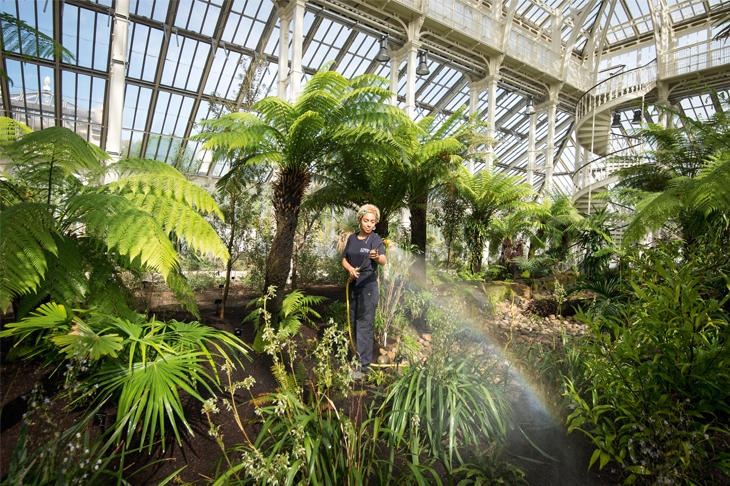The glasshouses at Kew Gardens are so popular that they can be quite unbearably busy at weekends. And why shouldn’t they be? They’re beautiful structures and the plants they shelter are so marvellous that they deserve the attention they get, whether from botany nerds, schoolchildren, or millennials dressed for Instagram and posing for selfies in the steamy leafy heat. But for the past five years, the biggest member of the Kew family has been closed to the public. Hidden under an enormous awning that the botanic gardens boasts could have covered three Boeing 747s (one of those area-the-size-of-Wales facts that mean very little), the Temperate House has been undergoing a lengthy restoration.
This isn’t just the largest glasshouse at Kew, it’s also the largest surviving Victorian glasshouse in the world. More pointless facts abound, such as the number of panes of glass (15,000) that needed replacing, urns that needed removing and restoring (116) and litres of paint used (5,280). The landscapers are still finishing off the area around the building, which first opened in 1863, and inside things don’t feel quite complete either. Though a number of the older, larger plants had to stay put while the builders worked around them, many were moved, and so everything naturally looks very freshly planted. There are some rather municipal-looking relatives of the common Busy Lizzie (Impatiens hawkeri) planted in the beds as a tribute to the floral displays that the original Victorian gardeners planted, and the soil looks shiny and new. The plants, from temperate regions across the world, will look much more at home after a few months, when they have started sprawling over one another and covering the soil with leaf mould and discarded petals.
That’s not to say that the whole thing isn’t glorious: one of the things that makes it feel so very new and shiny is the sheer scale of the glasshouse, and the amount of space it has, not just for the plants but also for people. Even a few days after its official opening, when two large groups of schoolchildren in bright orange reflective tabards trooped around the high galleries, peering down at the tree ferns and camellias, the place felt so light and airy. The roof is many times higher than the tallest trees. The main glasshouse has a large square in the middle. This means there is space to marvel at the male Encephalartos woodii — known as the ‘loneliest plant in the world’ because no female partner has been found in the wild — without tripping over other visitors.

The Temperate House at Kew
There are plenty of plants like the lonely Encephalartos whose stories are almost as marvellous as the organisms themselves. A Mauritian tree, Dombeya mauritiana, was declared extinct in the 1990s, but 15 years later one wild specimen pitched up. Horticulturalists from Kew clambered through a guava thicket before forming a human ladder to collect cuttings from the 10 metre tall specimen. Its clone now lives in the glasshouse. The St Helena ebony plant needed a similarly adventurous botanist to save it: after 100 years of being extinct, two plants turned up near the fabulously named Asses Ears. They were propagated by Charles Benjamin, who carried a stem of Trochetiopsis ebenus back up a mountain between his teeth.
Quieter but nonetheless still very intriguing plants grow next to these rarities in the beds and alongside the waterfalls and streams. In fact, there are 10,000 plants here, which is a more useful fact than how many panes of glass lie over them. Ferns with leaves divided many times, hoyas scrambling up poles, and the bright, unreal flowers of a bird of paradise.
The building was originally designed by Decimus Burton to solve the urgent problem of Kew’s temperate plants dying off because they had no suitable home. Temperate regions aren’t just where plants grow, but also where humans prefer to live, with a ‘Goldilocks’ climate that’s not too hot or too cold. This makes the plants’ lives rather difficult, as people keep building homes and roads on their habitats. In this building, though, everything gets on just splendidly.
The main atrium opens into two side conservatories where lines of potted pelargoniums and daisies lap up the sun, before leading visitors into two more large conservatories. Again, there is so much space that everyone rubs along quite happily. These buildings aren’t meant to contain cutting-edge garden design, though the structures themselves and the contrast between the white painted frame and its lush green inhabitants are both so beautiful that they beat many of the more pretentious gardens at the Chelsea Flower Show hands down.
Kew is really less about design and more about plantsmanship. It often holds just one of each species in its collections, rather than using repetitive planting for an effect (though the naturalised pink, claret and white tulips in the orchard right next to the glasshouse are quite lovely), but its definition of plantspeople is wide: the educational signs about the fact that it is the camellia that produces our tea leaves, for instance, are for novices who may not yet know their tree fern from their Chilean wine palm. There’s space for children with sketchbooks and PhD students studying the flora of eastern Australia. And that’s what really earns this Great Glasshouse its name: there are few places on earth where elderly experts and fizzy schoolchildren can stand side-by-side, all looking up in awe.







Comments